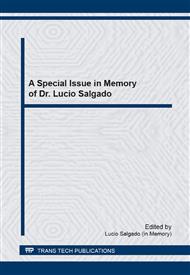p.331
p.337
p.343
p.350
p.356
p.362
p.368
p.374
p.380
Drawing Tantalum Encapsulated in the Cooper Pipe
Abstract:
Tantalum has characteristics such as excellent ductility, high corrosion resistance, high mechanical strength at high temperatures and high resistance to etching of acids and bases. Its high ductility allows the realization of large reductions without the need for intermediate heat treatment. A process for the production of tantalum wire is drawing. However, when using this process, the high ductility of the tantalum (Ta) metal causes a retention/accumulation of the Ta in the spinneret. Therefore, to be drawn is necessary that the tantalum is encapsulated in a copper tube. In this work was produced a Ta wire by means of rotary forging and drawing process. In the drawing process of the tantalum encapsulated in copper tube, was the appearance of striation on the surface of tantalum, when applied to an area reduction (AR) of approximately 22%. This fact is possibly related to the different sliding systems with consequent formation of non-hydrostatic stress fields at the interface Cu / Ta. After an area reduction (AR) of 94% the Cu was removed from the surface of the wire, through chemical etching, and this wire was drawn up to 0.43mm without retention/accumulation of the Ta in the spinneret.
Info:
Periodical:
Pages:
356-361
Citation:
Online since:
September 2014
Price:
Сopyright:
© 2015 Trans Tech Publications Ltd. All Rights Reserved
Share:
Citation:


